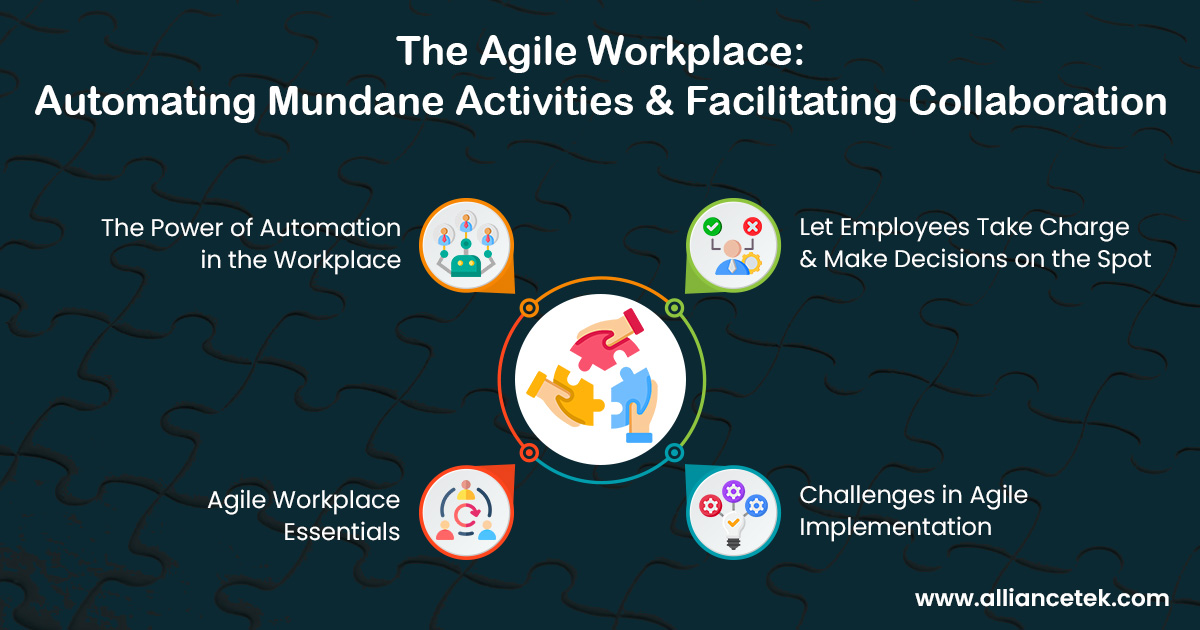Business complexity is increasing by the day. Corporations must produce more products or services – and variants of these products or services – for a growing number of markets. At the same time, faster-better-cheaper business models continue to proliferate while product innovation cycles continue to shrink.
It is no surprise, then, that knowledge workers face mounting and relentless pressure as they attempt to effectively manage increasingly complex processes.

The Power of Automation in the Workplace
Let's break down how automation in the workplace is a real game-changer in how businesses operate:
# Enhanced Productivity and Efficiency
Imagine having a super assistant who never gets tired, makes zero mistakes, and can do tedious tasks at lightning speed. That's what automation tools are like. They're perfect for taking over the boring stuff like data entry or scheduling meetings. This frees up everyone’s time so they can focus on more important work that requires a human touch, like coming up with new ideas or solving complex problems.
# Cost Reduction and Risk Mitigation
Making mistakes is part of being human. But in business, errors can be costly, and the risk of something going wrong always looms over manual processes. Enter automation: it cuts down on these mistakes because, well, machines follow instructions to the letter. Plus, they don’t get tired or distracted. This means businesses can save a good chunk of change that would otherwise be spent fixing errors.
# Empowering Employees
Here’s the thing about dull, repetitive tasks: no one likes them. They eat up time and energy that could be better spent elsewhere. Automation completes these assignments, further freeing up employees for complex tasks in which they can enjoy the fruits of their labor. It's not only about making the routine days a bit more enjoyable but also about creating space where people can shine and bring their expertise to the table, something machines can't replicate - such as working with clients and coming up with new ideas.
Agile Workplace Essentials
Lean office environments are designed to increase efficiency, promote cooperation, and automate repetitive work tasks. Through the adoption of digital technologies, these environments can respond to changes rapidly, encouraging employees who now are more self-driven and systems that are systemized.
# Automating Routine Tasks
In the case of agility, there is a major aspect of minimizing the manual repetitive tasks by automation. Not only does this approach involve efficiency, but it also ensures correctness. Through automating basic tasks, companies have the great capability to cut down on the human errors that often come with manual processes. Data entry, scheduling, and even complex calculations can be performed by automation tools to allow employees to shift their focus from the processes to the core of what they do.
Through digital transformation, creating connected, adaptive workplaces is the primary factor. It is a process that is encompassed in the implementation of digital technology in all aspects of business operations, thus revolutionizing how these processes are conducted and adding value to customers. It is one of the most crucial approaches in this transformation through offering major work instruments and communication platforms. These digital solutions enable:
- Instant Communication: Nowadays, as quick messaging and video calls are now available, employees can easily interact with each other irrespective of their physical closeness. This competency provides the frame for quick and good decision-making.
- Collaborative Platforms: Cloud services can now be used over multiple devices where several users can work on the same document or project in real time and communicate efficiently.
- Access to Critical Data: Agile workplaces accommodate workers with quick data access whenever required. This is achieved by way of centralized databases and information systems, which can then be accessed remotely, thus making it possible for the members of the team to retrieve and analyze information without delay.
- Automated Workflows: Through the implementation of automated workflows in a daily agenda, tasks that require input or approval by other departments can be simplified. The systemization of these processes helps to execute them smoothly with less human interaction.
Let Employees Take Charge and Make Decisions on the Spot
An agile work environment gives great credit to those who can swiftly adapt to the changes and make culminated decisions. This responsiveness results from the continually changing global economy where shorter product cycles and delivery times are in extreme demand.
# Automation of Business Processes
The core of quick decisions is the automation of processes that are routine and repetitive in the business world. By eliminating the necessity for manual interventions, workers have extra time to direct their attention to tasks important for strategic planning which require human cognitive aptitude. Automation simplifies and accelerates work streams, and reduces the order processing period and the chance of mistakes, which makes a more productive workplace.
# Use of Business Intelligence
Business intelligence tools are of great importance in empowering employees. BI systems supply instantaneous data and analytics, which give out information about consumer behavior, market developments, and efficiency of operations in real time. The availability of this data empowers employees to make quick and informed decisions, foresee market fluctuations, and proactively counter them.
# Adapting to the Global Economy
The global economy's evolution demands agility from businesses. With product life cycles becoming shorter and the pressure to deliver products and services faster, employees must be capable of adjusting their strategies and decisions rapidly. An agile workplace fosters an environment where making decisions in nearly real-time becomes a standard practice.
Challenges in Agile Implementation
By introducing agile methodology into business, there are some specific complications to address this problem thoughtfully and carefully. These challenges are typically grouped under people, processes, and systems.
# People
Agile methodology sets an organization-wide goal of bringing up the communication and teamwork skills of every participant.
# Building a Collaborative Culture
Developing a setting favoring free interaction and joint solving of issues as rules. Such an approach comprises the elimination of functional fences and the promotion of cross-functional teams to cooperate effectively.
# Adapting to Change
Team members need to be flexible and not oppose any change but face it bravely. This will require a mind shift for many though, which is different from the usual paradigm that is structurally categorized.
# Continuous Learning
Agile teams must be ready to develop continually with regular learning and improvement; therefore, organizational support on training and resources is vital for the staff to master new skills.
# Implementing Agile Workflows
Changing from a waterfall or a usual project management approach to agile methodology will take some getting used to. It involves reassessing the project scope, timelines, and content to be more adaptive and cyclical in approach.
# Maintaining Quality
Agility, primarily, speaks to speed and adaptability, while this results in a lower quality of the output is a difficulty. Balancing short development cycles and in-depth quality assurance procedures is very important and challenging.
# Scaling Agile Practices
As organizations grow, scaling the concept of agile approach to the collective efforts of large teams and projects while maintaining the core principles of agility is going to be a major hurdle.
# Selecting the Right Tools
Selecting tools that meet the requirements of the personal team and projects, starting from software of control to communication platforms is overwhelming. The most important thing is to choose instruments that only support, not obstruct Agile principles.
# Integration Challenges
The process of incorporating new tools into currently running systems without disturbing the established workflows is an insistent technical problem. Compatibility and functioning without a hitch across different platforms is non-negotiable to avoid the slowing down of productivity.
# Training and Adaptation
The training of staff on newly introduced skills is imperative since they should be able to use them properly. Generally, there is a threshold from the transition of new technologies, therefore, it hampers for a little while the productivity.
The only way to deal with this question is to make everyone in the organization care, starting with the top management to individual team members. Successful agile implementation is not only about having a new set of tools and procedures but about creating an environment that encourages changes and hails collaboration and continuous learning.
Along the process of making companies more agile, AllianceTek becomes the main actor. They are proficient in automating repeatable processes and improving the performance of machines and devices. It is this that entails the analysis of present processes, pointing out areas of improvement, and introducing changes that shape how businesses work.
Seeking to establish a nimble work environment that would not only optimize existing processes but also be scalable, the company anticipates growth and future challenges.
Call us at 484-892-5713 or Contact Us today to know more details about The Agile Workplace: Automating Mundane Activities and Facilitating Collaboration.


